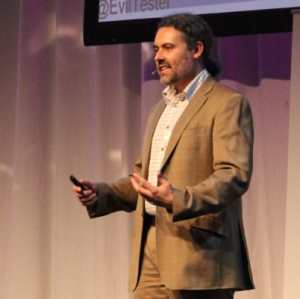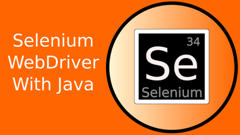In November 2012 I presented A Keynote at Eurostar entitled “Unconventional Influences”, and co-presented a tutorial with Simon Stewart the “Selenium Clinic”. The tutorial won an award for best Tutorial at the conference.
Keynote Slides
Keynote Paper
Since I entitled the talk “Unconventional Influences” I tried to make the paper as unconventional as I could, so it covers the essence of the talk but not the material. I republished this as part of Dear Evil Tester
The Influences
I have written up a model of my “Unconventional Influences” keynote from Eurostar 2012, it has the times when I think I should have mentioned certain things, and it has links to references that I hopefully referred to, at the time when I scheduled the reference.
It may not make sense out of context, but if you attended then this may help you follow up on the sources of my influences.
- 17:00 My Eurostar 2012 “Unconventional Influences” talk should start about now
- 17:01 Here comes a minute by minute predictive summary and influences list
- 17:02 I have unconventional “Unconventional influences” and conventional “Unconventional influences”
- 17:03 I have changed the way that I think about, talk about, learn about, and do; software testing.
- 17:04 Everyone has a personal test approach.
- 17:05 When I started in testing I did everything ‘right’, but I made one big mistake
- 17:06 I left my critical thinking and skepticism at the door
- 17:07 by DrFaustusAU http://drfaustusau.deviantart.com/art/The-Call-of-Cthulhu-Cover-276564815
- 17:08 Humans can hold multiple belief systems so that the real world never has to interact with the work world
- 17:09 Software Testing does not exist
- 17:10 We made up Software Testing, we can continue to make it up
- 17:11 I have some Unconventional Influences, that have influenced me Unconventionally in Unconventional ways
- 17:12 http://www.forteantimes.com/
- 17:13 http://www.amazon.com/Charles-Fort-Man-Invented-Supernatural/dp/B001LRPTEI
- 17:14 The works of Charles Fort http://www.resologist.net/
- 17:15 Monstrum http://www.amazon.com/Monstrum-Wizards-Tale-Tony-Shiels/dp/1905723555
- 17:16 Despite what you see here, I work in the real world
- 17:17 I care because I want people to manifest their potential
- 17:18 ASSAP https://www.assap.ac.uk
- 17:19 http://www.maglite.com/product.asp?psc=6DCELL
- 17:20 http://drfaustusau.deviantart.com/gallery/?q=ghostbusters
- 17:22 http://en.wikipedia.org/wiki/Fads_and_Fallacies_in_the_Name_of_Science
- 17:23 http://www.generalsemantics.org/
- 17:24 The Map is not the Territory
- 17:25 http://en.wikipedia.org/wiki/E-Prime
- 17:26 https://eviltester.github.io/TestingApp/apps/eprimer/eprimer.html
- 17:27 I can tell you want I do. I won’t tell you what software testing ‘is’
- 17:28 Build your own web of influences. Use the Bibliography and the Biography.
- 17:29 http://en.wikipedia.org/wiki/The_Avenger_%28character%29
- 17:30 http://pespmc1.vub.ac.be/REQVAR.html
- 17:32 I tell people what I plan to do, and why, then we can agree how to label it
- 17:33 http://en.wikipedia.org/wiki/Milton_H._Erickson
- 17:34 https://www.ernestrossi.com/ernestrossi/Burden%20of%20Responsibility.pdf
- 17:35 work from first principles
- 17:36 https://eviltester.com/2011/10/build-your-own-model-of-software-testing-or-rediscover-one-from-several-thousand-years-ago.html
- 17:37 Feedback, Feedback, Feedback
- 17:38 Responsibility, Responsibility, Responsibility
- 17:39 Your influences will help you if you trust them
- 17:40 Add the unique value that only you uniquely can
Other Outputs
- I created a webinar in preparation for Eurostar Thinking Visually in Software Testing
- As part of the Eurostar promotion I wrote an article in Professional Tester entitled Abstraction in Action dealing with some Test Automation abstraction principles.
- I hosted a Tutorial with Simon Stewart (@shs96c, blog) called “Selenium Clinic”, it seemed to go well, and we won the Best Tutorial Award, so thanks to everyone who attended and provided such positive feedback.
- We released the source code to the tutorial on github, under Simon’s account. We have more in the code than we covered, we didn’t manage to really cover the page and domain object exercises in the tutorial
- code on github https://github.com/shs96c/selenium_clinic
- And I managed to make it onto next year’s Programme Committee chaired by Michael Bolton) – terribly exciting to have a chance to help shape a conference that I first attended in 1995.
Conference Reflections
- I loved the testing keynotes – not a single duffer and everyone hit the conference theme ( I hope I can include mine in that statement)
- Alan Page, fully bearded up – any respectable Alan knows he should present himself thusly, encouraged building a web of ideas and seeking out new knowledge, and now that I have his gamer tag I can see when he beats me on Trials HD
- Simon Stewart, fully bearded up – as any respectable WebDriver speaker knows he should present himself, gave a good overview of the history of Selenium, with parts I didn’t know before.
- Mike Kelly, gave a really interesting overview of start-ups and testing therein. Good links to various lean startup style material: leancanvas (see also DeveloperTown)
- All of the above talks, and myself included encouraged a focus on value, constantly learning, and bringing in new ideas.
- I also enjoyed the non-testing keynotes:
- John Seddon summarised his process using call centre improvement as an example. I have read all of John’s books and can recommend them. I like John’s approach of going back to the source so we don’t get stuck at Womack’s marketing version of lean, instead research back to Deming and Taiichi Ohno.
- John doesn’t really mention Juran, so I will here – recommended for your on-going management study.
- Peter Madsen gave a great talk about hobby building submarines and rocket ships, and I took away more weight behind the notion that we just have to get on with the doing and take responsibility for overcoming our obstacles.
- John Seddon summarised his process using call centre improvement as an example. I have read all of John’s books and can recommend them. I like John’s approach of going back to the source so we don’t get stuck at Womack’s marketing version of lean, instead research back to Deming and Taiichi Ohno.
- Esther Gons created a summary visualisation of all the keynotes, with a few other lucky speakers getting the visualisation treatment.
- I didn’t attend too many track sessions:
- Alexandra Schladebeck linked World of Warcraft (which I haven’t played, but might now) gave a good overview of Agile using WoW as the illustration and used the entertaining “Leroy Jenkins” video as an illustration of planning and teamwork. Esther Gons provided a visualisation of this talk.
- Adrian Rapan talked about Security Testing using WebDriver with his source code on Google code
- Graham Thomas’s track session reminded me that we used to auto-generate applications, we don’t seem to do as much of that anymore
- Olli-Pekka Puolitaival presented the OSMO model based testing tool and this stood out as something I want to spend time investigating. Open sourced, using Java, simple annotation based. I haven’t tried it yet, but I will.
- And Fiona Charles’s workshop on Mind-mapping gave me a chance to see how other people approach mind mapping – I wandered around the room to look at the output of the different groups
- I spent much of the time standing around speaking to people. I met too many people to mention, as you tend to at conferences, some great people from the testing world that I hadn’t really bumped in to before. Consequently I didn’t get as much time as I wanted to speak to people that I have met before, and some people I only waved to in passing.
- Somehow I missed the cake to celebrate Eurostar’s 20th Birthday.
- I won’t mention the evening
drinkingdining and socialising, Eurostar always has a good social environment, this year proved no exception.
Tutorial Notes
Simon Stewart (@shs96c, blog) and I presented the “Selenium Clinic” a half day tutorial on WebDriver.
We won the award for Best Tutorial.
We prepared a shed load of material, just in case no-one asked any questions.
Fortunately people did ask questions and the tutorial organised itself around the questions people had. We mostly managed to cover all the material we had. We didn’t get around to covering Page Object models in much depth and I don’t think we really covered domain models.
Fortunately, we released all the source code we produced in preparation on github, including the Page Object models and Domain Object models.
I used a subset of slides pulled from my WebDriver course as the clinic handouts because the slides on this course act as pretty good reference material.
A few interesting things to note when you look through the clinic code:
- Simon packaged up the necessary jars individually in the repo. I tend to just include selenium-server-standalone-xxx.jar so I found it a learning experience to see what he included.
- The code has a good mix of static and non-static includes of ExpectedConditions.
- Some usage of Hamcrest matchers to illustrate making the code literate
- Simon created a custom By method which I hadn’t had to do before so I enjoyed learning that.
- Creating custom ExpectedConditions
- Also compare the style differences in the tests between using Page Objects and Domain Objects
Tutorial Slides
I released the slides which were given to the tutorial attendees up on slideshare.
I was a little nervous about this because of those 72 slides, 50 of them form part of my Online course and I put a lot of material, detail, time and energy into them. But I now view them as something which might help people learn more about WebDriver. So I’m learning to let go.
I don’t really update those slides, but I do update the 230+ slides on the Selenium WebDriver course.








